Advanced Financial Accounting: Mark to Market and Apple's Reporting
VerifiedAdded on 2023/06/07
|10
|2630
|138
Report
AI Summary
This report delves into the accounting practices that led to Enron's collapse, focusing on the role of mark-to-market accounting and the use of special purpose entities (SPEs) to hide debt and inflate profits. It also examines Enron's stock compensation schemes and their impact on management's behavior. Furthermore, the report analyzes Apple Inc.'s financial reporting methodologies under US GAAP, including the measurement of share-based compensation, property, plant, and equipment, inventories, and deferred tax assets and liabilities. It evaluates the decision-usefulness of these methods, particularly in relation to inventory valuation and impairment, and discusses the fair value approach used for available-for-sale securities, emphasizing the importance of regular portfolio review to accurately reflect market changes. The analysis highlights how different accounting practices can significantly impact a company's financial picture and operating results.

15 September 2018
Advanced Financial Accounting
Advanced Financial Accounting
Secure Best Marks with AI Grader
Need help grading? Try our AI Grader for instant feedback on your assignments.

Part A
Role of Mark to Market Accounting Approach in Enron’s fall
The company Enron was formed in the year 1985, as a result of the merger between Houston
Natural Gas Co. and Omaha-based InterNorth Inc. (Matoussi and Jardak, 2012). One of the
major reasons that formed the base for the fall of the company was the top management’s
decision to lead Enron from a conventional historical cost accounting method to the mark to
market (MTM) accounting method (West, 2018). In order to do the same, the company had
got sanction from the U.S. Securities and Exchange Commission in the year 1992. The
company had incorporated the mark to market accounting approach for the energy trading
business. The mark to market approach is the measurement of the fair values of the various
accounts of an entity, that can change over a time, as in the case of assets and liabilities. The
aim behind using such an approach is to display a more realistic appraisal of the company’s
current financial situation. The company Enron used the approach to manipulate the financial
statements, this is because the fair value determination is a complex process (Kim and Zhang,
2016). This is because of the fact that commodities such as gas do not often have a quoted
price upon which to base the valuations of the fair value.
Under this approach, whenever the company Enron had an outstanding balance in relation to
energy and other derivative contract related asset or the liability balance, the same was
required to be adjusted to the fair value as at the end of a particular quarter (Rimkus, 2017).
The resulting unrealised gains or losses were booked in the income statement for that period.
As there is difficulty in determination of the fair value prices, the companies like Enron are
free to use and develop a range of the discretionary models for the valuation that are based on
their own assumptions and estimates. The company Enron was under a consistent pressure to
get pass the earnings estimate, in response to which the valuation estimates used by the entity
were considerably made to overstate the earnings. As per the reports, the unrealised gains of
Role of Mark to Market Accounting Approach in Enron’s fall
The company Enron was formed in the year 1985, as a result of the merger between Houston
Natural Gas Co. and Omaha-based InterNorth Inc. (Matoussi and Jardak, 2012). One of the
major reasons that formed the base for the fall of the company was the top management’s
decision to lead Enron from a conventional historical cost accounting method to the mark to
market (MTM) accounting method (West, 2018). In order to do the same, the company had
got sanction from the U.S. Securities and Exchange Commission in the year 1992. The
company had incorporated the mark to market accounting approach for the energy trading
business. The mark to market approach is the measurement of the fair values of the various
accounts of an entity, that can change over a time, as in the case of assets and liabilities. The
aim behind using such an approach is to display a more realistic appraisal of the company’s
current financial situation. The company Enron used the approach to manipulate the financial
statements, this is because the fair value determination is a complex process (Kim and Zhang,
2016). This is because of the fact that commodities such as gas do not often have a quoted
price upon which to base the valuations of the fair value.
Under this approach, whenever the company Enron had an outstanding balance in relation to
energy and other derivative contract related asset or the liability balance, the same was
required to be adjusted to the fair value as at the end of a particular quarter (Rimkus, 2017).
The resulting unrealised gains or losses were booked in the income statement for that period.
As there is difficulty in determination of the fair value prices, the companies like Enron are
free to use and develop a range of the discretionary models for the valuation that are based on
their own assumptions and estimates. The company Enron was under a consistent pressure to
get pass the earnings estimate, in response to which the valuation estimates used by the entity
were considerably made to overstate the earnings. As per the reports, the unrealised gains of
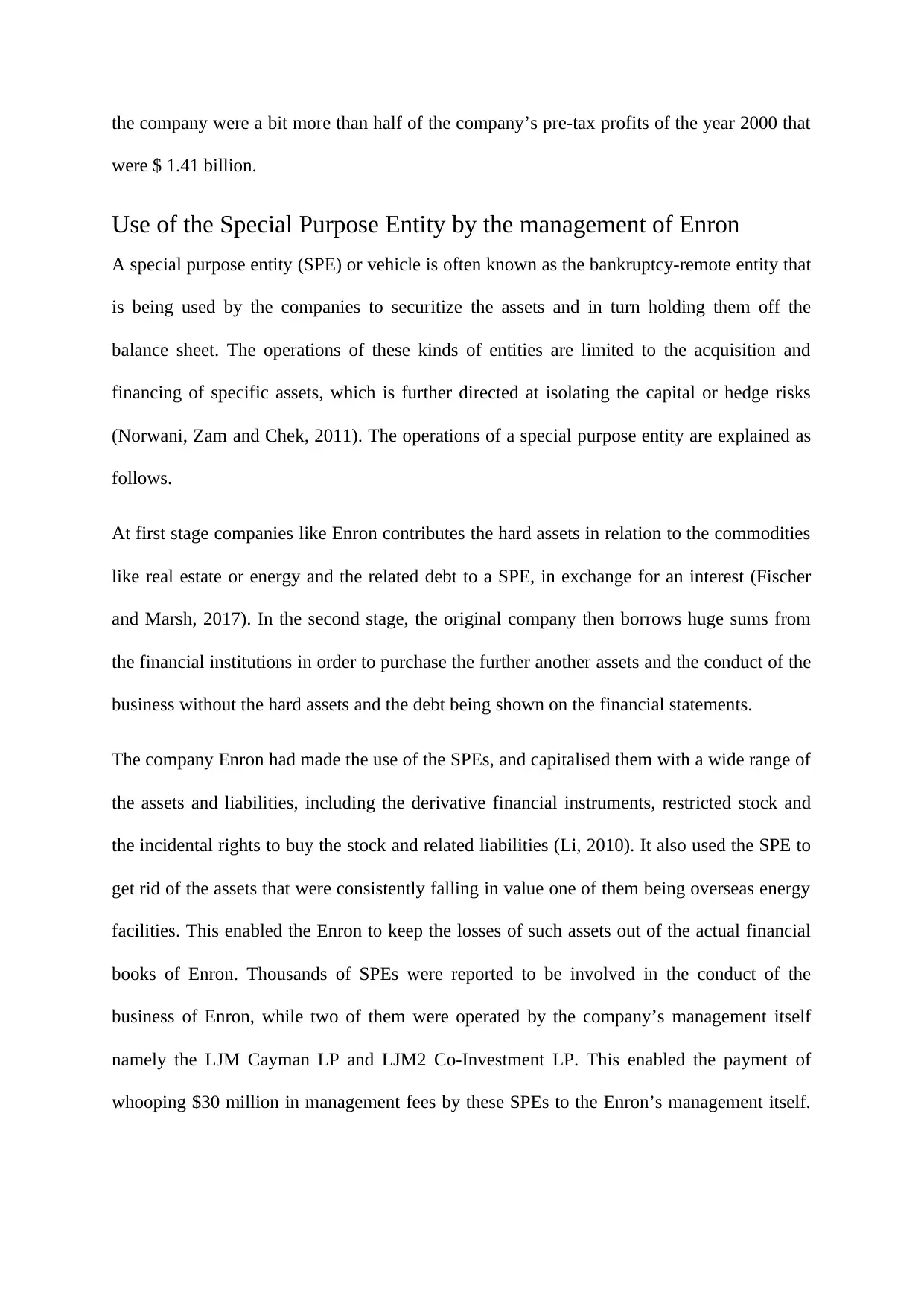
the company were a bit more than half of the company’s pre-tax profits of the year 2000 that
were $ 1.41 billion.
Use of the Special Purpose Entity by the management of Enron
A special purpose entity (SPE) or vehicle is often known as the bankruptcy-remote entity that
is being used by the companies to securitize the assets and in turn holding them off the
balance sheet. The operations of these kinds of entities are limited to the acquisition and
financing of specific assets, which is further directed at isolating the capital or hedge risks
(Norwani, Zam and Chek, 2011). The operations of a special purpose entity are explained as
follows.
At first stage companies like Enron contributes the hard assets in relation to the commodities
like real estate or energy and the related debt to a SPE, in exchange for an interest (Fischer
and Marsh, 2017). In the second stage, the original company then borrows huge sums from
the financial institutions in order to purchase the further another assets and the conduct of the
business without the hard assets and the debt being shown on the financial statements.
The company Enron had made the use of the SPEs, and capitalised them with a wide range of
the assets and liabilities, including the derivative financial instruments, restricted stock and
the incidental rights to buy the stock and related liabilities (Li, 2010). It also used the SPE to
get rid of the assets that were consistently falling in value one of them being overseas energy
facilities. This enabled the Enron to keep the losses of such assets out of the actual financial
books of Enron. Thousands of SPEs were reported to be involved in the conduct of the
business of Enron, while two of them were operated by the company’s management itself
namely the LJM Cayman LP and LJM2 Co-Investment LP. This enabled the payment of
whooping $30 million in management fees by these SPEs to the Enron’s management itself.
were $ 1.41 billion.
Use of the Special Purpose Entity by the management of Enron
A special purpose entity (SPE) or vehicle is often known as the bankruptcy-remote entity that
is being used by the companies to securitize the assets and in turn holding them off the
balance sheet. The operations of these kinds of entities are limited to the acquisition and
financing of specific assets, which is further directed at isolating the capital or hedge risks
(Norwani, Zam and Chek, 2011). The operations of a special purpose entity are explained as
follows.
At first stage companies like Enron contributes the hard assets in relation to the commodities
like real estate or energy and the related debt to a SPE, in exchange for an interest (Fischer
and Marsh, 2017). In the second stage, the original company then borrows huge sums from
the financial institutions in order to purchase the further another assets and the conduct of the
business without the hard assets and the debt being shown on the financial statements.
The company Enron had made the use of the SPEs, and capitalised them with a wide range of
the assets and liabilities, including the derivative financial instruments, restricted stock and
the incidental rights to buy the stock and related liabilities (Li, 2010). It also used the SPE to
get rid of the assets that were consistently falling in value one of them being overseas energy
facilities. This enabled the Enron to keep the losses of such assets out of the actual financial
books of Enron. Thousands of SPEs were reported to be involved in the conduct of the
business of Enron, while two of them were operated by the company’s management itself
namely the LJM Cayman LP and LJM2 Co-Investment LP. This enabled the payment of
whooping $30 million in management fees by these SPEs to the Enron’s management itself.

Thus, while losses were kept at bay using the SPEs, benefits were being availed by the
management of Enron.
Stock Compensation Scheme and the management of Enron
The breach of the agency theory occurs when the agents fail to appropriately represent the
best interest of the principals. In the case of the corporations, the directors and the top
management of the company are entrusted with the responsibility of managing the affairs of
the entity (Bosse and Phillips, 2016). The directors do so in the capacity of the agents acting
for the principal, i.e. the corporation and the stakeholders. The board of directors of the
company Enron had failed to carry out the role of the regulator in the company, and did not
pay adequate attention to their oversight responsibilities, due to which the company had
ventured into the illegal activities that were opposed to the general interest and benefit of the
stakeholders (Deutsch, Keil and Laamanen, 2011).
The company Enron used to award about annual options that equalised to about 5 percent of
the salary of the individuals. The percentage of the employees that were awarded such
options was around 60 percent. In addition to the employees, executives and the top managers
also did used to get such options. It is significant to note that at the end of the year 2000,
almost all the managers and the employees of the Enron possessed options. These could have
been exercised for about 47 million shares in return. While the average strike price of the
stock options at Enron was about $30, and at the end of the year 2000, the average trading
price of the same in the market was about $83. Thus, the total profit that could have been
earned exercising the options was approximately $2.5 billion. The existence of the huge
rewards made these options seem lucrative and favourite for the top executives and the
directors of the company. In order to yield the maximum out of these options, the top
management even tried to influence these options (Markham, 2015). This was done by
projecting the optimistic profits in the upcoming years.
management of Enron.
Stock Compensation Scheme and the management of Enron
The breach of the agency theory occurs when the agents fail to appropriately represent the
best interest of the principals. In the case of the corporations, the directors and the top
management of the company are entrusted with the responsibility of managing the affairs of
the entity (Bosse and Phillips, 2016). The directors do so in the capacity of the agents acting
for the principal, i.e. the corporation and the stakeholders. The board of directors of the
company Enron had failed to carry out the role of the regulator in the company, and did not
pay adequate attention to their oversight responsibilities, due to which the company had
ventured into the illegal activities that were opposed to the general interest and benefit of the
stakeholders (Deutsch, Keil and Laamanen, 2011).
The company Enron used to award about annual options that equalised to about 5 percent of
the salary of the individuals. The percentage of the employees that were awarded such
options was around 60 percent. In addition to the employees, executives and the top managers
also did used to get such options. It is significant to note that at the end of the year 2000,
almost all the managers and the employees of the Enron possessed options. These could have
been exercised for about 47 million shares in return. While the average strike price of the
stock options at Enron was about $30, and at the end of the year 2000, the average trading
price of the same in the market was about $83. Thus, the total profit that could have been
earned exercising the options was approximately $2.5 billion. The existence of the huge
rewards made these options seem lucrative and favourite for the top executives and the
directors of the company. In order to yield the maximum out of these options, the top
management even tried to influence these options (Markham, 2015). This was done by
projecting the optimistic profits in the upcoming years.
Secure Best Marks with AI Grader
Need help grading? Try our AI Grader for instant feedback on your assignments.
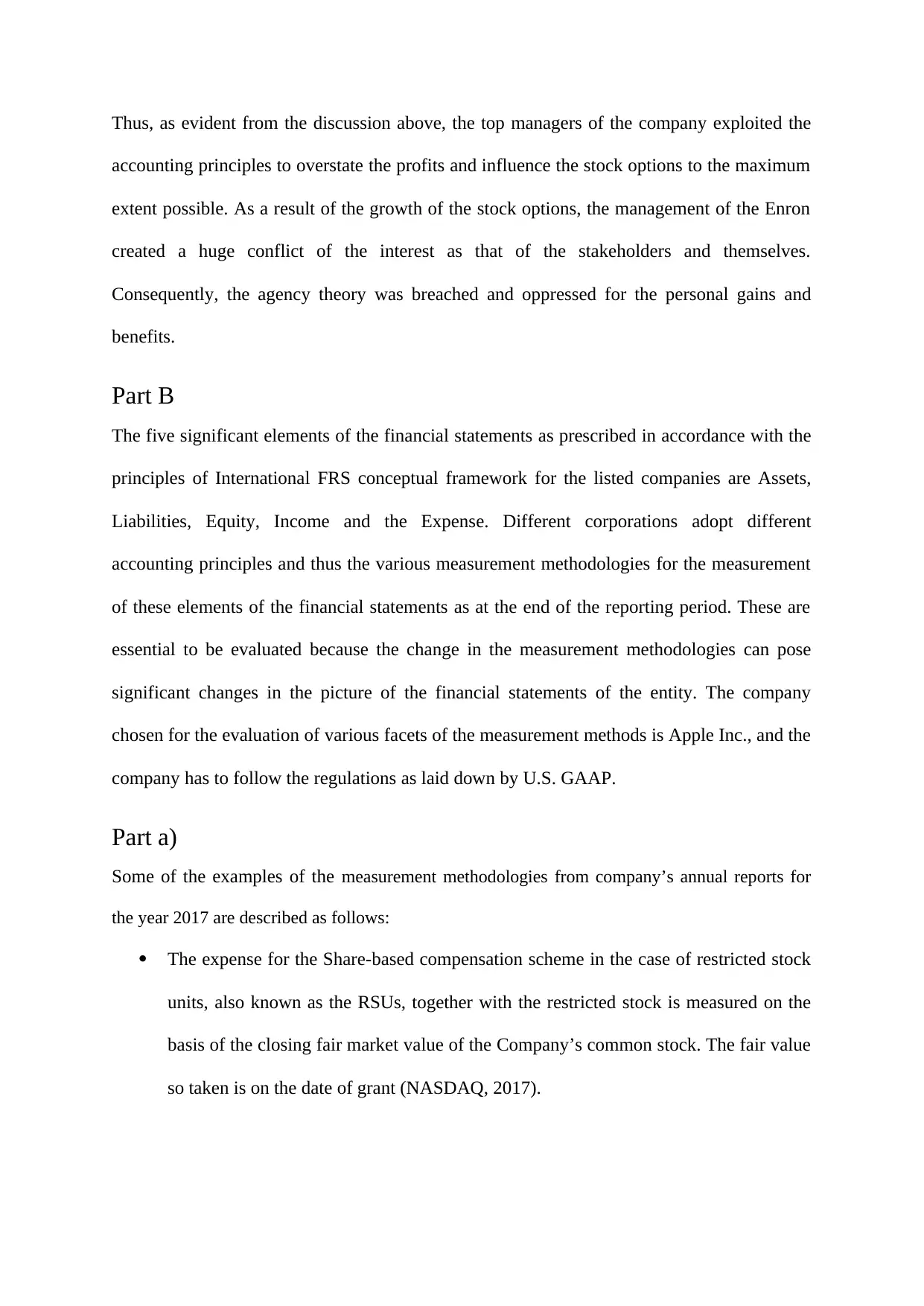
Thus, as evident from the discussion above, the top managers of the company exploited the
accounting principles to overstate the profits and influence the stock options to the maximum
extent possible. As a result of the growth of the stock options, the management of the Enron
created a huge conflict of the interest as that of the stakeholders and themselves.
Consequently, the agency theory was breached and oppressed for the personal gains and
benefits.
Part B
The five significant elements of the financial statements as prescribed in accordance with the
principles of International FRS conceptual framework for the listed companies are Assets,
Liabilities, Equity, Income and the Expense. Different corporations adopt different
accounting principles and thus the various measurement methodologies for the measurement
of these elements of the financial statements as at the end of the reporting period. These are
essential to be evaluated because the change in the measurement methodologies can pose
significant changes in the picture of the financial statements of the entity. The company
chosen for the evaluation of various facets of the measurement methods is Apple Inc., and the
company has to follow the regulations as laid down by U.S. GAAP.
Part a)
Some of the examples of the measurement methodologies from company’s annual reports for
the year 2017 are described as follows:
The expense for the Share-based compensation scheme in the case of restricted stock
units, also known as the RSUs, together with the restricted stock is measured on the
basis of the closing fair market value of the Company’s common stock. The fair value
so taken is on the date of grant (NASDAQ, 2017).
accounting principles to overstate the profits and influence the stock options to the maximum
extent possible. As a result of the growth of the stock options, the management of the Enron
created a huge conflict of the interest as that of the stakeholders and themselves.
Consequently, the agency theory was breached and oppressed for the personal gains and
benefits.
Part B
The five significant elements of the financial statements as prescribed in accordance with the
principles of International FRS conceptual framework for the listed companies are Assets,
Liabilities, Equity, Income and the Expense. Different corporations adopt different
accounting principles and thus the various measurement methodologies for the measurement
of these elements of the financial statements as at the end of the reporting period. These are
essential to be evaluated because the change in the measurement methodologies can pose
significant changes in the picture of the financial statements of the entity. The company
chosen for the evaluation of various facets of the measurement methods is Apple Inc., and the
company has to follow the regulations as laid down by U.S. GAAP.
Part a)
Some of the examples of the measurement methodologies from company’s annual reports for
the year 2017 are described as follows:
The expense for the Share-based compensation scheme in the case of restricted stock
units, also known as the RSUs, together with the restricted stock is measured on the
basis of the closing fair market value of the Company’s common stock. The fair value
so taken is on the date of grant (NASDAQ, 2017).
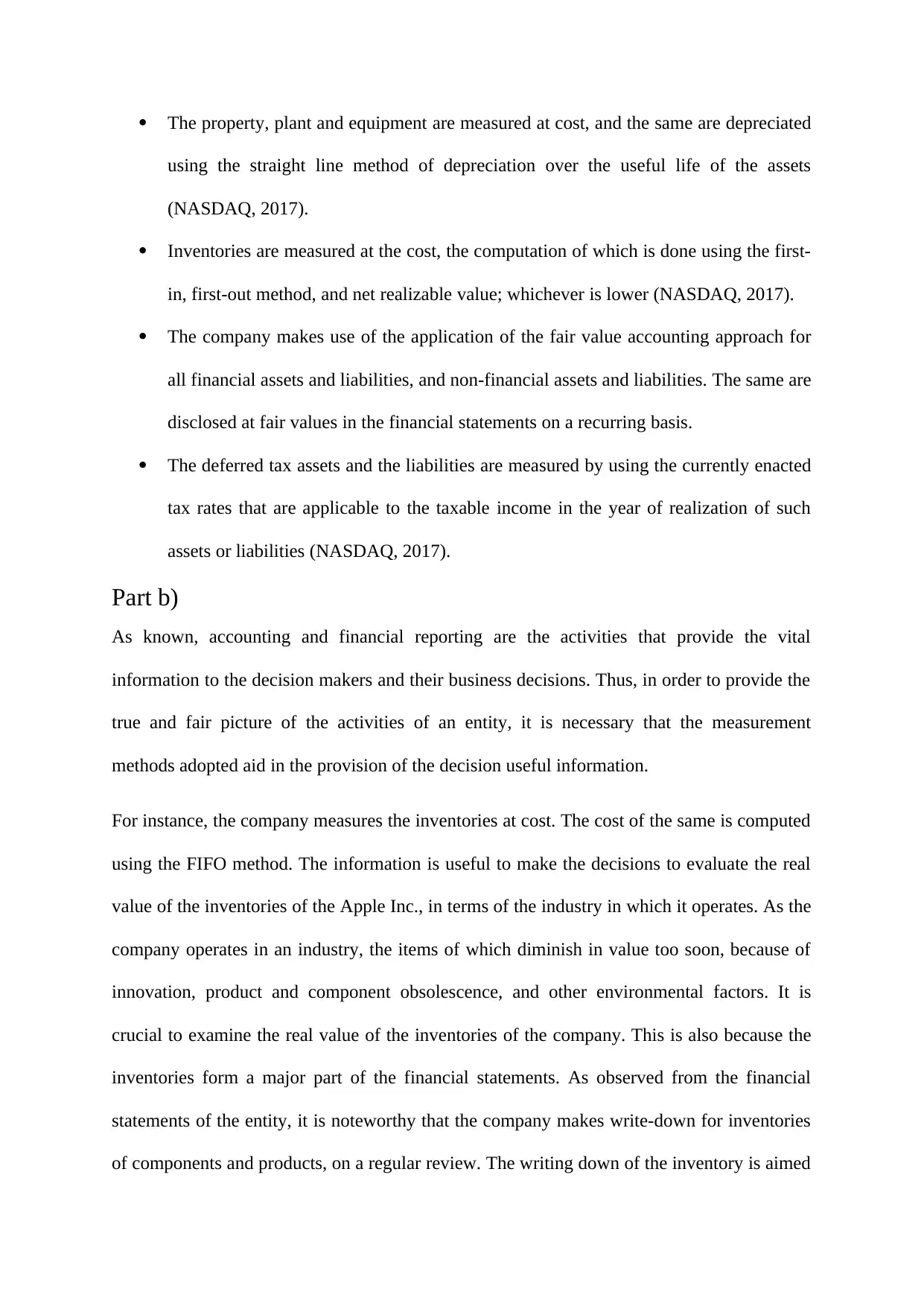
The property, plant and equipment are measured at cost, and the same are depreciated
using the straight line method of depreciation over the useful life of the assets
(NASDAQ, 2017).
Inventories are measured at the cost, the computation of which is done using the first-
in, first-out method, and net realizable value; whichever is lower (NASDAQ, 2017).
The company makes use of the application of the fair value accounting approach for
all financial assets and liabilities, and non-financial assets and liabilities. The same are
disclosed at fair values in the financial statements on a recurring basis.
The deferred tax assets and the liabilities are measured by using the currently enacted
tax rates that are applicable to the taxable income in the year of realization of such
assets or liabilities (NASDAQ, 2017).
Part b)
As known, accounting and financial reporting are the activities that provide the vital
information to the decision makers and their business decisions. Thus, in order to provide the
true and fair picture of the activities of an entity, it is necessary that the measurement
methods adopted aid in the provision of the decision useful information.
For instance, the company measures the inventories at cost. The cost of the same is computed
using the FIFO method. The information is useful to make the decisions to evaluate the real
value of the inventories of the Apple Inc., in terms of the industry in which it operates. As the
company operates in an industry, the items of which diminish in value too soon, because of
innovation, product and component obsolescence, and other environmental factors. It is
crucial to examine the real value of the inventories of the company. This is also because the
inventories form a major part of the financial statements. As observed from the financial
statements of the entity, it is noteworthy that the company makes write-down for inventories
of components and products, on a regular review. The writing down of the inventory is aimed
using the straight line method of depreciation over the useful life of the assets
(NASDAQ, 2017).
Inventories are measured at the cost, the computation of which is done using the first-
in, first-out method, and net realizable value; whichever is lower (NASDAQ, 2017).
The company makes use of the application of the fair value accounting approach for
all financial assets and liabilities, and non-financial assets and liabilities. The same are
disclosed at fair values in the financial statements on a recurring basis.
The deferred tax assets and the liabilities are measured by using the currently enacted
tax rates that are applicable to the taxable income in the year of realization of such
assets or liabilities (NASDAQ, 2017).
Part b)
As known, accounting and financial reporting are the activities that provide the vital
information to the decision makers and their business decisions. Thus, in order to provide the
true and fair picture of the activities of an entity, it is necessary that the measurement
methods adopted aid in the provision of the decision useful information.
For instance, the company measures the inventories at cost. The cost of the same is computed
using the FIFO method. The information is useful to make the decisions to evaluate the real
value of the inventories of the Apple Inc., in terms of the industry in which it operates. As the
company operates in an industry, the items of which diminish in value too soon, because of
innovation, product and component obsolescence, and other environmental factors. It is
crucial to examine the real value of the inventories of the company. This is also because the
inventories form a major part of the financial statements. As observed from the financial
statements of the entity, it is noteworthy that the company makes write-down for inventories
of components and products, on a regular review. The writing down of the inventory is aimed
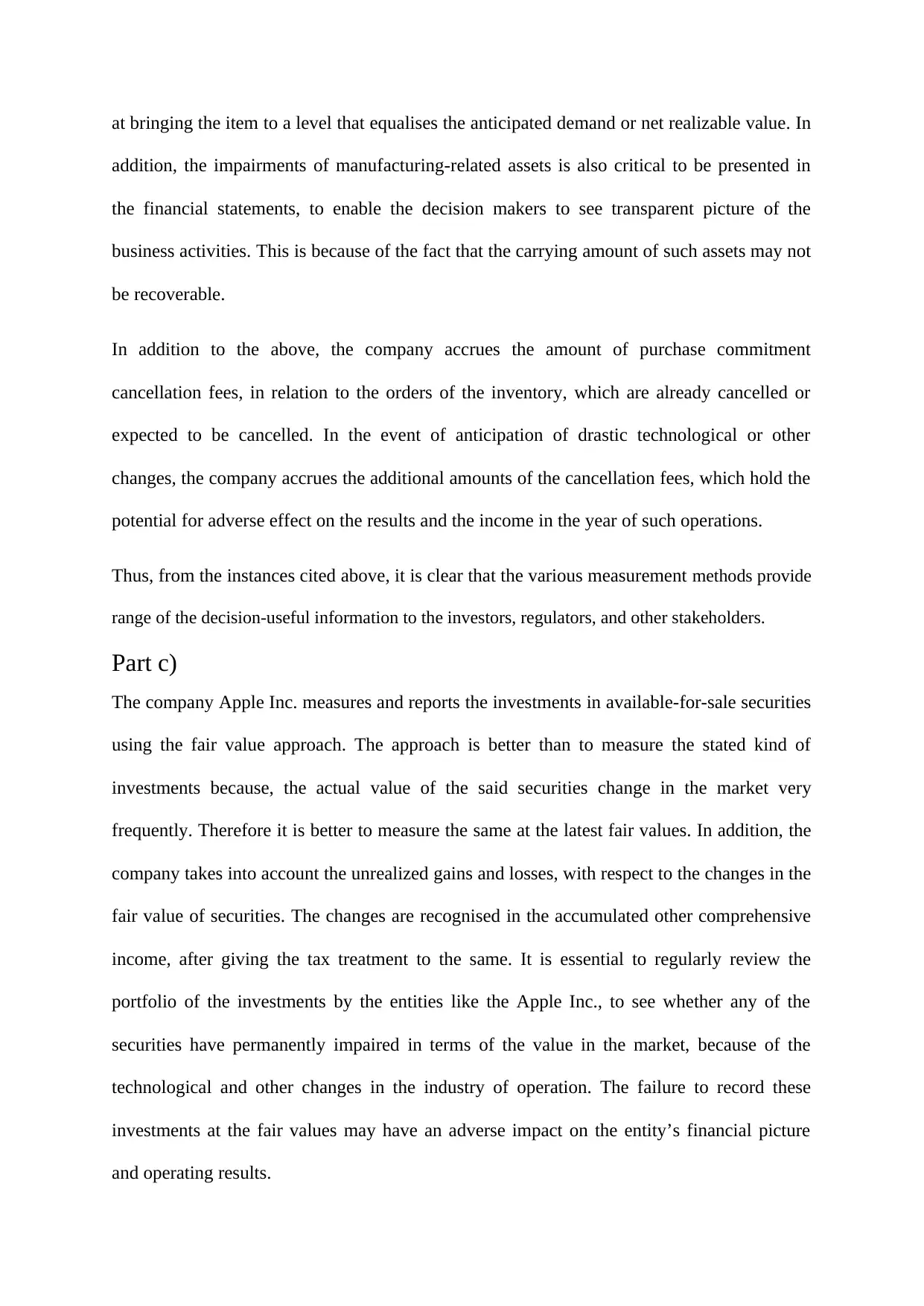
at bringing the item to a level that equalises the anticipated demand or net realizable value. In
addition, the impairments of manufacturing-related assets is also critical to be presented in
the financial statements, to enable the decision makers to see transparent picture of the
business activities. This is because of the fact that the carrying amount of such assets may not
be recoverable.
In addition to the above, the company accrues the amount of purchase commitment
cancellation fees, in relation to the orders of the inventory, which are already cancelled or
expected to be cancelled. In the event of anticipation of drastic technological or other
changes, the company accrues the additional amounts of the cancellation fees, which hold the
potential for adverse effect on the results and the income in the year of such operations.
Thus, from the instances cited above, it is clear that the various measurement methods provide
range of the decision-useful information to the investors, regulators, and other stakeholders.
Part c)
The company Apple Inc. measures and reports the investments in available-for-sale securities
using the fair value approach. The approach is better than to measure the stated kind of
investments because, the actual value of the said securities change in the market very
frequently. Therefore it is better to measure the same at the latest fair values. In addition, the
company takes into account the unrealized gains and losses, with respect to the changes in the
fair value of securities. The changes are recognised in the accumulated other comprehensive
income, after giving the tax treatment to the same. It is essential to regularly review the
portfolio of the investments by the entities like the Apple Inc., to see whether any of the
securities have permanently impaired in terms of the value in the market, because of the
technological and other changes in the industry of operation. The failure to record these
investments at the fair values may have an adverse impact on the entity’s financial picture
and operating results.
addition, the impairments of manufacturing-related assets is also critical to be presented in
the financial statements, to enable the decision makers to see transparent picture of the
business activities. This is because of the fact that the carrying amount of such assets may not
be recoverable.
In addition to the above, the company accrues the amount of purchase commitment
cancellation fees, in relation to the orders of the inventory, which are already cancelled or
expected to be cancelled. In the event of anticipation of drastic technological or other
changes, the company accrues the additional amounts of the cancellation fees, which hold the
potential for adverse effect on the results and the income in the year of such operations.
Thus, from the instances cited above, it is clear that the various measurement methods provide
range of the decision-useful information to the investors, regulators, and other stakeholders.
Part c)
The company Apple Inc. measures and reports the investments in available-for-sale securities
using the fair value approach. The approach is better than to measure the stated kind of
investments because, the actual value of the said securities change in the market very
frequently. Therefore it is better to measure the same at the latest fair values. In addition, the
company takes into account the unrealized gains and losses, with respect to the changes in the
fair value of securities. The changes are recognised in the accumulated other comprehensive
income, after giving the tax treatment to the same. It is essential to regularly review the
portfolio of the investments by the entities like the Apple Inc., to see whether any of the
securities have permanently impaired in terms of the value in the market, because of the
technological and other changes in the industry of operation. The failure to record these
investments at the fair values may have an adverse impact on the entity’s financial picture
and operating results.
Paraphrase This Document
Need a fresh take? Get an instant paraphrase of this document with our AI Paraphraser

Thus, as stated above, it can be said that techniques deployed by the companies are critical to
be examined to draw inference on the numbers as represented in the financial statements.
be examined to draw inference on the numbers as represented in the financial statements.
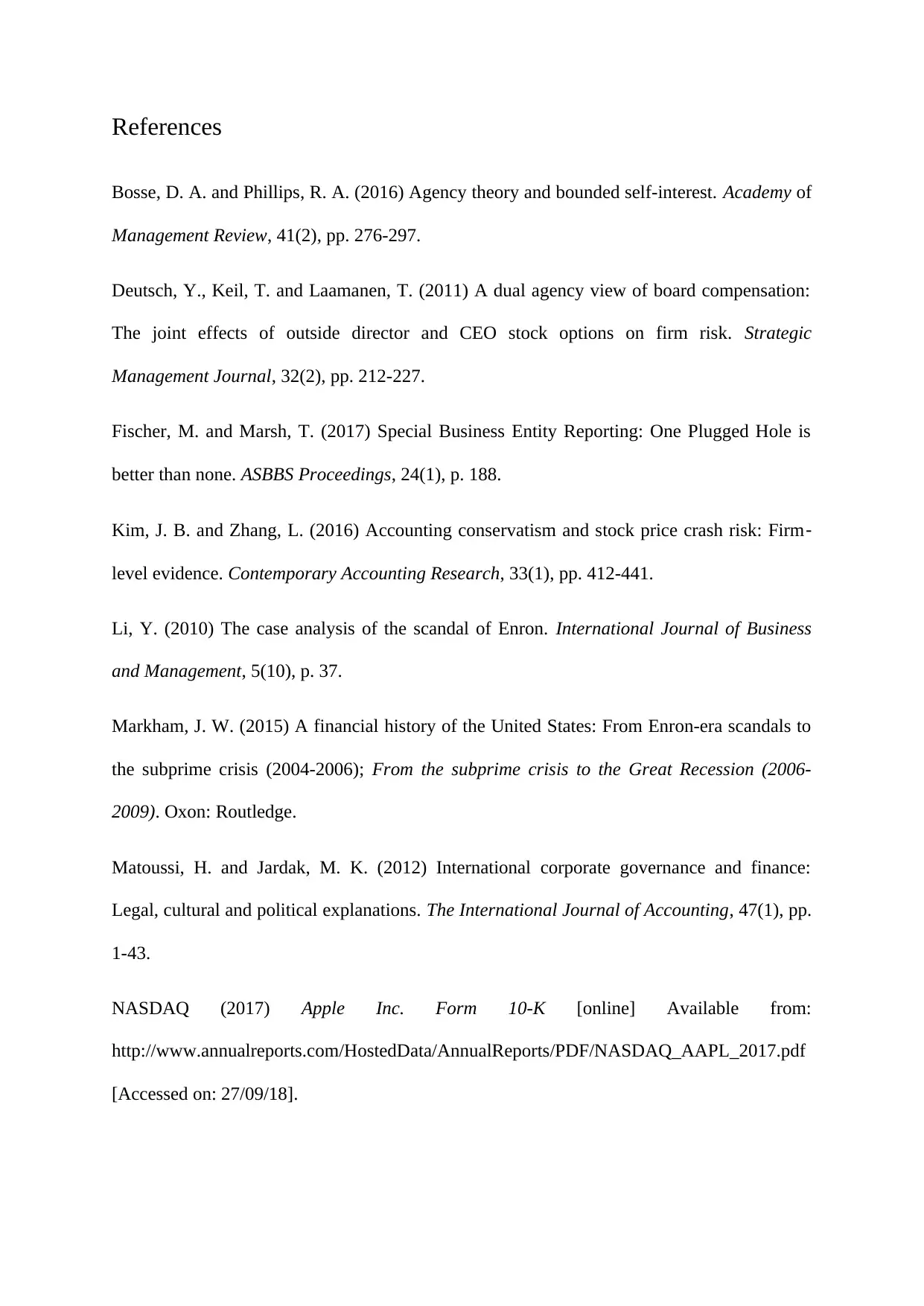
References
Bosse, D. A. and Phillips, R. A. (2016) Agency theory and bounded self-interest. Academy of
Management Review, 41(2), pp. 276-297.
Deutsch, Y., Keil, T. and Laamanen, T. (2011) A dual agency view of board compensation:
The joint effects of outside director and CEO stock options on firm risk. Strategic
Management Journal, 32(2), pp. 212-227.
Fischer, M. and Marsh, T. (2017) Special Business Entity Reporting: One Plugged Hole is
better than none. ASBBS Proceedings, 24(1), p. 188.
Kim, J. B. and Zhang, L. (2016) Accounting conservatism and stock price crash risk: Firm‐
level evidence. Contemporary Accounting Research, 33(1), pp. 412-441.
Li, Y. (2010) The case analysis of the scandal of Enron. International Journal of Business
and Management, 5(10), p. 37.
Markham, J. W. (2015) A financial history of the United States: From Enron-era scandals to
the subprime crisis (2004-2006); From the subprime crisis to the Great Recession (2006-
2009). Oxon: Routledge.
Matoussi, H. and Jardak, M. K. (2012) International corporate governance and finance:
Legal, cultural and political explanations. The International Journal of Accounting, 47(1), pp.
1-43.
NASDAQ (2017) Apple Inc. Form 10-K [online] Available from:
http://www.annualreports.com/HostedData/AnnualReports/PDF/NASDAQ_AAPL_2017.pdf
[Accessed on: 27/09/18].
Bosse, D. A. and Phillips, R. A. (2016) Agency theory and bounded self-interest. Academy of
Management Review, 41(2), pp. 276-297.
Deutsch, Y., Keil, T. and Laamanen, T. (2011) A dual agency view of board compensation:
The joint effects of outside director and CEO stock options on firm risk. Strategic
Management Journal, 32(2), pp. 212-227.
Fischer, M. and Marsh, T. (2017) Special Business Entity Reporting: One Plugged Hole is
better than none. ASBBS Proceedings, 24(1), p. 188.
Kim, J. B. and Zhang, L. (2016) Accounting conservatism and stock price crash risk: Firm‐
level evidence. Contemporary Accounting Research, 33(1), pp. 412-441.
Li, Y. (2010) The case analysis of the scandal of Enron. International Journal of Business
and Management, 5(10), p. 37.
Markham, J. W. (2015) A financial history of the United States: From Enron-era scandals to
the subprime crisis (2004-2006); From the subprime crisis to the Great Recession (2006-
2009). Oxon: Routledge.
Matoussi, H. and Jardak, M. K. (2012) International corporate governance and finance:
Legal, cultural and political explanations. The International Journal of Accounting, 47(1), pp.
1-43.
NASDAQ (2017) Apple Inc. Form 10-K [online] Available from:
http://www.annualreports.com/HostedData/AnnualReports/PDF/NASDAQ_AAPL_2017.pdf
[Accessed on: 27/09/18].
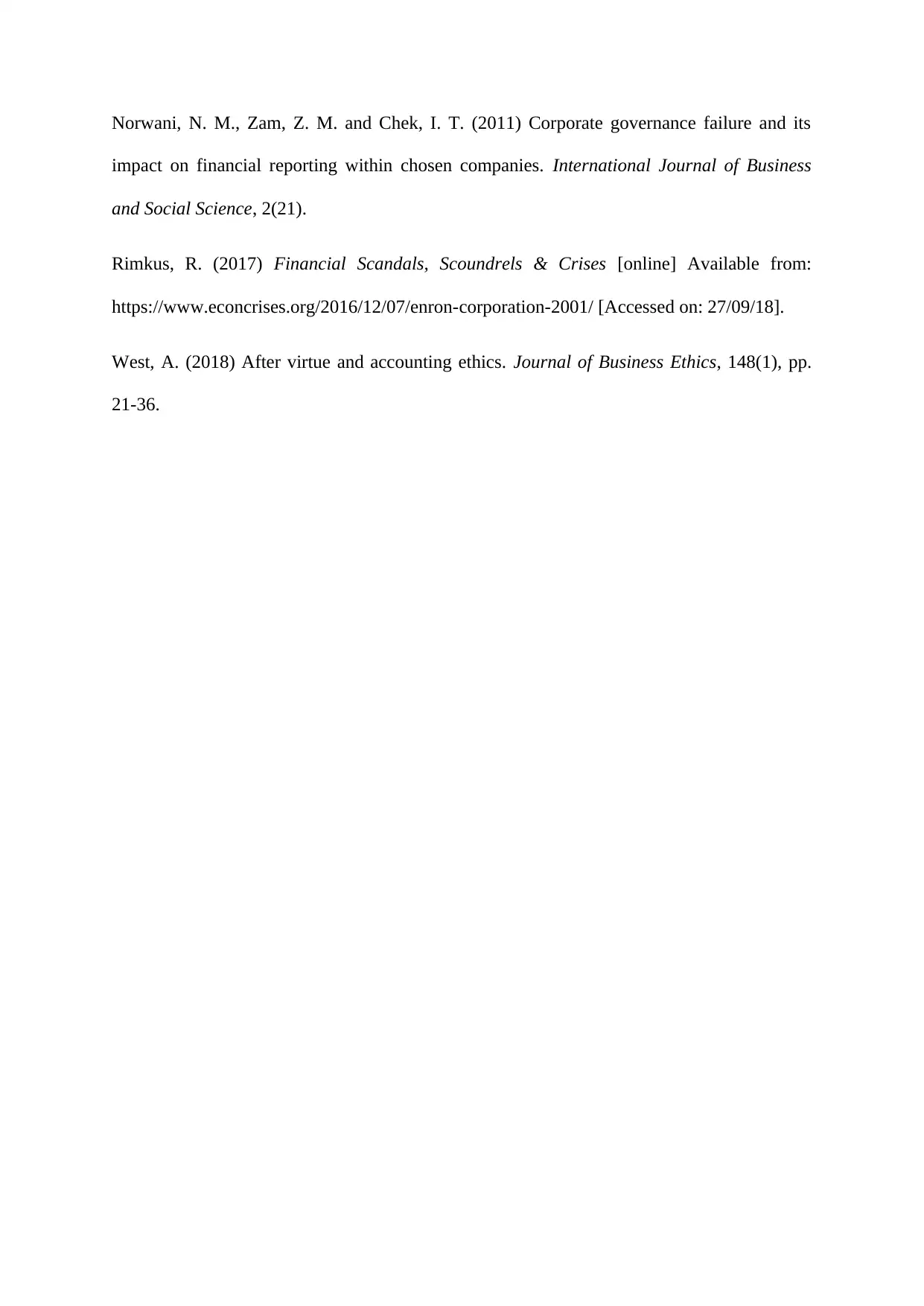
Norwani, N. M., Zam, Z. M. and Chek, I. T. (2011) Corporate governance failure and its
impact on financial reporting within chosen companies. International Journal of Business
and Social Science, 2(21).
Rimkus, R. (2017) Financial Scandals, Scoundrels & Crises [online] Available from:
https://www.econcrises.org/2016/12/07/enron-corporation-2001/ [Accessed on: 27/09/18].
West, A. (2018) After virtue and accounting ethics. Journal of Business Ethics, 148(1), pp.
21-36.
impact on financial reporting within chosen companies. International Journal of Business
and Social Science, 2(21).
Rimkus, R. (2017) Financial Scandals, Scoundrels & Crises [online] Available from:
https://www.econcrises.org/2016/12/07/enron-corporation-2001/ [Accessed on: 27/09/18].
West, A. (2018) After virtue and accounting ethics. Journal of Business Ethics, 148(1), pp.
21-36.
1 out of 10
Related Documents
Your All-in-One AI-Powered Toolkit for Academic Success.
+13062052269
info@desklib.com
Available 24*7 on WhatsApp / Email
![[object Object]](/_next/static/media/star-bottom.7253800d.svg)
Unlock your academic potential
© 2024 | Zucol Services PVT LTD | All rights reserved.




